Ad Blocker Detected
Our website is made possible by displaying online advertisements to our visitors. Please consider supporting us by disabling your ad blocker.
-
Excessive Plant Relocation
Frequent movement of plants from one location to another can cause stress and disrupt their ability to adapt. Each relocation requires them to readjust to new conditions, such as temperature, lighting, and humidity levels. If your plant is thriving in a specific area, moving it unnecessarily can be detrimental to its health. Once you find a suitable spot where your plant is thriving, it’s better to leave it there to maintain its well-being.
-
Sunburn and Leaf Scald
Sunburn, also known as leaf scald, can cause irreparable damage to plants and eventually lead to their demise. Sunburn occurs when plants are exposed to excessive direct sunlight. Signs of sunburn include browning or whitening of the leaf tips, as well as leaf drop. Plants that are suddenly moved from shade to direct sun or brought outdoors on sunny days are especially vulnerable.
To rescue a sunburned plant, relocate it to a shadier spot where it receives filtered sunlight. Adjust the watering routine, reducing it if the plant has lost leaves and gradually increasing it as new growth appears. Additionally, scale back on fertilizer application after leaf loss, gradually increasing it again as the plant regenerates.
-
Improper Fertilizer Usage

Plants require essential nutrients like nitrogen, phosphorus, and potassium to thrive and remain healthy. Regular fertilization is necessary to ensure these needs are met.
If plants are not fertilized adequately, you may observe lower leaves losing color and dropping off, new leaves becoming progressively smaller than older ones, and stunted stem growth. Using a balanced houseplant fertilizer on a consistent basis will promote the flourishing of your greenery.
However, it’s crucial to avoid over-fertilization, as it can cause harm. Signs of over-fertilization include wilting even when adequately watered, softening of leaves, and browning of leaf tips. Plants that exhibit vigorous foliage growth but minimal to no flowering may also indicate excessive fertilizer usage.
-
Inadequate Humidity Levels
While not all houseplants require high humidity, many thrive within a humidity range of 50% to 60%. Unfortunately, the average home often has lower humidity levels.
Plants require adequate humidity because their breathing pores lose significant moisture when the surrounding air is dry, and they cannot solely replenish it through the roots. Thin leaves typically have a higher need for humidity, while thick, leathery, waxy, or hairy leaves can tolerate lower levels.
If you notice crinkling and browning of leaf edges, drying of new leaf tips, or the browning and dropping of flower buds, it indicates insufficient humidity. You can increase humidity by using a humidifier, employing natural methods to humidify your home, relocating plants to the kitchen or bathroom, or placing the pots on a bed of moist gravel to enhance moisture around the plants.
Spotting Bad Advice
Having eliminated some poor plant care practices, it’s essential to learn how to differentiate between good and bad advice moving forward. One of the simplest ways to identify terrible houseplant advice is by understanding your plant’s natural habitat. Once you grasp how they thrive in the wild, it becomes much easier to anticipate their preferences in your home environment.
By having this knowledge, you can effectively discern between good and bad advice. For example, consider the suggestion of planting succulents in a terrarium. If you are aware of where succulents naturally grow, it becomes apparent that the humid conditions within a terrarium are not suitable for them.
Admittedly, this requires some research and additional effort. However, the end result will be a happy and healthy plant that flourishes into a mature specimen.

